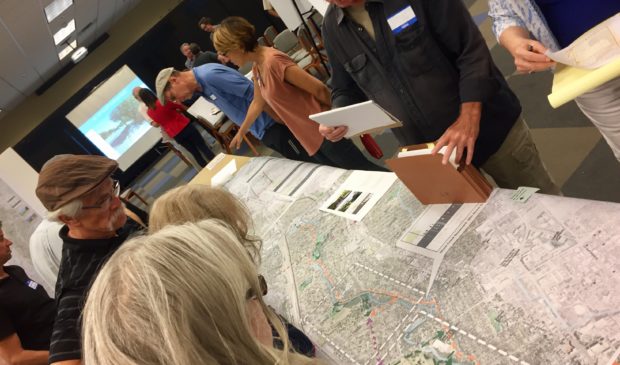One small trail for North Austin, one giant loop for the whole city
Friday, September 15, 2017 by
Caleb Pritchard Last year, Mayor Steve Adler declared in his State of the City address that great cities do big things, a message that the Shoal Creek Conservancy apparently took to heart.
On Wednesday evening at a community workshop in Central Austin, the group officially debuted its vision for the Big Loop, a 30-mile circular system of existing and future urban trails.
The concept would allow cyclists to ride on the Shoal Creek Trail from downtown to connect to the Walnut Creek Trail at the Domain. Heading east from there, the route eventually bends southward and would ultimately connect to the Lance Armstrong Bikeway, which pushes west back towards downtown. The loop would also connect to the Ann and Roy Butler Hike and Bike Trail as well as the upcoming Violet Crown Trail that will eventually lead all the way south to Hays County.
The largest missing link in that plan is a 13-mile gap between the Shoal Creek Trail’s current terminus at West 35 Street and the Domain.
With assistance from the city of Austin, the Capital Metropolitan Transportation Authority and the Central Texas Regional Mobility Authority, the conservancy is currently cobbling together its Shoal Creek Trail: Vision to Action Plan.
“What we don’t want is the plan to go sit on a shelf, so we consciously chose the ‘vision to action’ name,” Executive Director Joanna Wolaver told the Austin Monitor. “So it’s putting the vision down on paper and then defining actionable steps so that we can immediately start implementing it.”
She said the main object of the plan is to figure out how much the 13-mile extension would cost. The eventual price tag, she explained, would likely be covered through a public-private partnership.
As many as 100 people showed up to Congregation Beth Israel on Wednesday evening for the planning effort’s second community workshop. Several large maps of the Shoal Creek corridor were set up on easels or laid out across tables. Participants placed sticky notes on specific areas to provide suggestions or record concerns.
Determining the route of the trail north of its current terminus up to U.S. Highway 183 could prove to be contentious. One proposal is to create a two-way cycle track on Shoal Creek Boulevard, a street notorious in the city’s annals of bicycle planning. Seeking to appease cyclists and residents with shallow driveways, the city in the mid-2000s split the baby and striped off lanes intended for both cyclists and parked cars.
However, several residents along Shoal Creek Boulevard told the Monitor that they would not mind the changes.
“One of the big impediments to people cycling is safety,” Janis Connell said. “I teach bike safety, so I’m not scared to take my place on the road and take the lane if I need to take the lane, but that’s a huge impediment for other people.”
Another potential obstacle is the possible routing of the extension through Austin Memorial Park, a city-owned cemetery on Hancock Drive. Wolaver insisted that no specific pathway has been yet determined and that the entire point of the workshop was to probe the community’s preferences.
However, one highly certain component of the plan is the utilization of a bicycle and pedestrian crossing of U.S. 183 that will be provided by the CTRMA through its MoPac Improvement Project. Once the trail clears that barrier, tracing it to the Domain through the maze of warehouses and the University of Texas’ J. J. Pickle Research Campus will provide problems of a more logistical rather than political nature.
The conservancy will conduct one more community workshop on Nov. 15 at a location still to be determined. Wolaver predicted that the plan will be finalized by February. From there, she said, it will be submitted to the relevant city boards and commissions. If it clears those, it will ultimately head for final approval by City Council.
The Austin Monitor’s work is made possible by donations from the community. Though our reporting covers donors from time to time, we are careful to keep business and editorial efforts separate while maintaining transparency. A complete list of donors is available here, and our code of ethics is explained here.
You're a community leader
And we’re honored you look to us for serious, in-depth news. You know a strong community needs local and dedicated watchdog reporting. We’re here for you and that won’t change. Now will you take the powerful next step and support our nonprofit news organization?



